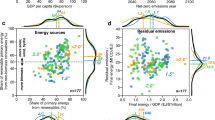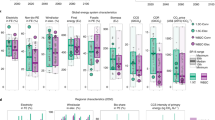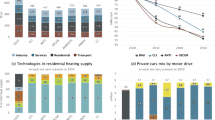Abstract
Access to clean, affordable and reliable energy has been a cornerstone of the world's increasing prosperity and economic growth since the beginning of the industrial revolution. Our use of energy in the twenty–first century must also be sustainable. Solar and water–based energy generation, and engineering of microbes to produce biofuels are a few examples of the alternatives. This Perspective puts these opportunities into a larger context by relating them to a number of aspects in the transportation and electricity generation sectors. It also provides a snapshot of the current energy landscape and discusses several research and development opportunities and pathways that could lead to a prosperous, sustainable and secure energy future for the world.
This is a preview of subscription content, access via your institution
Access options
Subscribe to this journal
Receive 51 print issues and online access
$199.00 per year
only $3.90 per issue
Buy this article
- Purchase on Springer Link
- Instant access to full article PDF
Prices may be subject to local taxes which are calculated during checkout









Similar content being viewed by others
References
Lee, R. The outlook for population growth. Science 333, 569–573 (2011).
International Energy Agency in World Energy Outlook 2011, 546–547 http://www.worldenergyoutlook.org (International Energy Agency, 2011).
Committee on America's Energy Future, National Academy of Sciences, National Academy of Engineering and National Research Council. America's Energy Future: Technology and Transformation (National Academies Press, 2009).
US Department of Energy. Report on the First Quadrennial Technology Review. http://energy.gov/sites/prod/files/QTR_report.pdf (US DOE, 2011).
BP. BP Statistical Review of World Energy. http://bp.com/statisticalreview2012. (BP, 2012).
Maugeri, L. Oil: The Next Revolution. Discussion Paper 2012–10. http://belfercenter.ksg.harvard.edu/files/Oil-%20The%20Next%20Revolution.pdf (Belfer Center for Science and International Affairs, Harvard Kennedy School, 2012).
Inderwildi, O. & King, D. (eds). Energy, Transport, & the Environment, Addressing the Sustainable Mobility Paradigm. (Springer, 2012).
US Department of Energy. Quadrennial Technology Review report, vol. II Technology Assessments http://energy.gov/articles/department-energy-releases-inaugural-quadrennial-technology-review-report (US Department of Energy, 2011).
Gibbs, J., Pesaran, A. A., Sklad, P. S. & Marlino, L. D. in Fundamentals of Materials for Energy and Environmental Sustainability (eds Ginley, D. S. & Cahen D.) Ch. 31, 426–444 (Cambridge Univ. Press, 2012).
Powers, W. F., Automotive materials in the 21st century. Adv. Mater. Process. 157, 38–41 (2000).
Cuddy, M. R. & Wipke, K. B. Analysis of Fuel Economy Benefit of Drivetrain Hybridization. http://www.nrel.gov/vehiclesandfuels/vsa/pdfs/22309.pdf (National Renewable Energy Laboratory, 1997).
Holmberg, K., Anderssona, P. & Erdemirb, A. Global energy consumption due to friction in passenger cars. Tribol. Int. 47, 221–234 (2012).
Schafer, A., Heywood, J. B. & Weiss, M. A. Future fuel cell and internal combustion engine automobile technologies: a 25-year life cycle and fleet impact assessment. Energy 31, 2064–2087 (2006).
Manley, D. K., McIlroy, A. & Taatjes, C. A. Research needs for future internal combustion engines. Physics Today 61, 47–52 (2008).
Yang, J. & Caillat, T. Thermoelectric materials for space and automotive power generation. MRS Bull. 31, 224–229 (2006).
Scrosati, B. & Grache, J. Lithium batteries: status, prospects and future. J. Power Sources 195, 2419–2430 (2010).
McCone, A. Electric Vehicle Battery Prices Down 14% Year on Year http://www.bnef.com/PressReleases/view/210 (Bloomberg New Energy Finance, 2012).
Chan, C. C. The state of the art of electric, hybrid, and fuel cell vehicles. Proc. IEEE 95, 704–718 (2007).
Lukic, S. M., Cao, J., Bansal, R. C., Rodriguez, F. & Emadi, A. Energy storage systems for automotive applications. IEEE Trans. Ind. Electron. 55, 2258–2267 (2008).
Spendelow, J. & Papageorgopoulos, D. Progress in PEMFC MEA component R&D at the DOE fuel cell technologies program. Fuel Cells 11, 775–786 (2011).
Debe, M. K. Electrocatalyst approaches and challenges for automotive fuel cells. Nature 486, 43–51 (2012).
Yang, J., Sudik, A., Wolverton, C. & Siegel, D. J. High capacity hydrogen storage materials: attributes for automotive applications and techniques for materials discovery. Chem. Soc. Rev. 39, 656–675 (2010).
Paster, M. D. et al. Hydrogen storage technology options for fuel cell vehicles: well-to-wheel costs, energy efficiencies, and greenhouse gas emissions. Int. J. Hydrogen Energy 36, 14534–14551 (2011).
David, E. An overview of advanced materials for hydrogen storage. J. Mater. Process. Technol. 162–163, 169–177 (2005).
Murray, L. J., Dincă, M. & Long, J. R. Hydrogen storage in metal–organic frameworks. Chem. Soc. Rev. 38, 1294–1314 (2009).
Abbas, H. F. & Wan Daud, W. M. A. Hydrogen production by methane decomposition: A review. Int. J. Hydrogen Energy 35, 1160–1190 (2010).
Krupnick, A. J. Will Natural Gas Vehicles be in Our Future. http://www.rff.org/RFF/Documents/RFF-IB-11-06.pdf (Resources for the Future, 2011).
NACS. Key Facts and Figures. http://www.nacsonline.com/NACS/Resources/campaigns/GasPrices_2011/Pages/default.aspx (NACS, 2011).
America's Energy Future Panel. Liquid Transportation Fuels. (National Academies Press, 2009).
Environmental Protection Agency. Renewable Fuel Standard Program (RFS2): Final Rulemaking http://www.epa.gov/otaq/fuels/renewablefuels/regulations.htm (US Environmental Protection Agency, 2010).
United Nations Environment Programme. Towards Sustainable Production of and use of resources: Assessing Biofuels http://www.unep.org/publications/contents/pub_details_search.asp?ID=4082 (United Nations Environment Programme, 2009).
Stratton, R. W., Wong, H. M. & Hileman, J. I. Quantifying variability in life cycle greenhouse gas inventories of alternative middle distillate transportation fuels. Environ. Sci. Technol. 45, 4637–4644 (2011).
Peralta-Yahya, P. P., Zhang, F., del Cardayre, S. B. & Keasling, J. D. Progress in the microbial production of advanced biofuels: from feedstocks to fuels. Nature 488, 320–328 (2012).
Worldwatch Institute. Biofuels for Transport (Routledge, 2007).
Georgianna, D. R. & Mayfield, S. P. Exploiting diversity and synthetic biology for the production algae biofuels, Nature 488, 329–335 (2012).
Zhu, X-, G., Long, S. P. & Ort, D. R. What is the maximum efficiency with which photosynthesis can convert solar energy into biomass? Curr. Opin. Biotechnol. 19, 153–159 (2008).
Conrado, R. J. et al. in Electrofuels: A new paradigm for renewable fuels. Advanced Biofuels and Bioproducts (Lee, J. ed.) (Springer, 2012).
International Energy Agency. World Energy Outlook 2011 179,186 http://www.worldenergyoutlook.org/ (International Energy Agency, 2011).
International Energy Agency. World Energy Outlook 2011, 180 http://www.worldenergyoutlook.org/ (International Energy Agency, 2011).
US Energy Information Administration. Annual Energy Outlook 2011 Levelized Cost Supplement http://www.eia.gov/forecasts/archive/aeo11/electricity_generation.cfm (US Energy Information Administration, 2011)
Bloomberg New Energy Finance. Levelised Cost of Energy Update, Q3 2012 http://www.bnef.com/WhitePapers/download/114 (Bloomberg New Energy Finance, 2012).
Wiser, R., Lantz E., Bolinger, M. & Hand, M. Recent Developments in the Levelized Cost of Energy from U.S. Wind Power Projects. http://eetd.lbl.gov/ea/ems/reports/wind-energy-costs-2-2012.pdf (US Department of Energy, 2012).
Galen Barbose, G. Darghouth, N., Wiser, R. & Seel, J. Tracking the Sun: An Historical Summary of the Installed Cost of Photovoltaics in the United States from 1998 to 2010 http://eetd.lbl.gov/ea/ems/reports/lbnl-5047e.pdf (Lawrence Berkeley National Laboratory report, 2011).
Solar Energy Industries Association. US Solar Market Insight Report Q1 2012 http://www.seia.org/research-resources/us-solar-market-insight (Solar Energy Industries Association, 2012).
Hand, M. M. et al. Renewable Electricity Futures Study http://www.nrel.gov/analysis/re_futures/ (National Renewable Energy Laboratory, 2012).
US Department of Energy. SunShot Vision Study http://www1.eere.energy.gov/solar/pdfs/47927.pdf (US Department of Energy, 2012).
Baziliana, M. et al. Re-considering the Economics of Photovoltiac Power www.bnef.com/WhitePapers/download/82 (Bloomberg New Energy Finance, 2012).
Swanson, R. M. Plenary talk at the DOE SunShot Grand Challenge: Summit and Technology Forum on June 14, 2012 https://www.eeremultimedia.energy.gov/solar/videos/sunshot_summit_richard_swanson_plenary_session (US Department of Energy, 2012).
US Department of Energy. SunShot Initiative http://www1.eere.energy.gov/solar/sunshot/accelerating_deployment.html (US Department of Energy, 2012).
Swanson, R. M. Proc. 31st IEEE Photovoltaic Specialists Conf. 889–894 (2005).
Graetzel M. Jannsen, R. A., Mitzi, D. B. & Sargent, E. H. Materials interface engineering for solution-processed photovoltaics, Nature 488, 304–312 (2012).
Stoddard, N., Wu B., Maisano, L., Russell, Clark, R. & Fernandez, J. M. The Leading Edge of Silicon Casting Technology and BP Solar's Mono2 Wafers, in 18th Workshop on Crystalline Silicon Solar Cells & Modules: Materials and Processes. pp. 7–14. http://www.nrel.gov/docs/fy08osti/45745.pdf (National Renewable Energy Laboratory, 2008).
Mavrokefalos, A., Han, S. E., Yerci, S., Branham, M. S. & Chen, G. Efficient light trapping in inverted nanopyramid thin crystalline silicon membranes for solar cell applications. Nano Lett. 12, 2792–2796 (2012).
Solexel. Solexel unveils ultra-thin, high-performance silicon solar cell at Intersolar. http://www.solexel.com/IntersolarNA2012.php (Solexel, 2012).
Rao, R. A. et al. Proc. 37th IEEE Photovoltaic Specialists Conf. 1504–1507 (2011).
Sachs, E. M., Wallace R. L., Hantsoo, E. T., Lorenz, A. M., Hudelson S.G.D. & Jonczyk, R. Methods for efficiently making thin semiconductor bodies from molten material for solar cells and the like, US Patent Application 20120067273 (2012).
Garland J. W., Biegala, T., Carmody, M., Gilmore, C. & Sivananthan, S. Next-generation multijunction solar cells: The promise of II-VI materials. J. Appl. Phys. 109, 102423 (2011).
Miller, O. D., Yablonovitch, E. & Kurtz, S. R. Strong internal and external luminescence as solar cells approach the Shockley–Queisser limit. IEEE J. Photovolt. 2, 303–311 (2012).
Angel, R. & Olbert, B. H. Method of manufacturing large dish reflectors for a solar concentrator apparatus. US Patent Application 20120125400 (2011).
Gur, I., Sawyer, K. & Prasher, R. Searching for a better thermal battery. Science 335, 1454–1455 (2012).
Advanced Research Projects Agency-Energy. ARPA-E Efficient Power Conversion Factsheet. http://arpa-e.energy.gov/Portals/0/Documents/FundedProjects/ADEPT%20Slicksheets/ADEPT_Program_Final_One%20Pager.pdf (Advanced Research Projects Agency-Energy, 2010).
Bolinger, M. & Wiser, R. Understanding wind turbine price trends in the U.S. over the past decade. Energy Pol. 42, 628–641 (2012).
US Department of Energy. Critical Materials Strategy. http://energy.gov/sites/prod/files/piprod/documents/cms_dec_17_full_web.pdf (US Department of Energy, 2010)
National Research Council. Minerals, Critical Minerals, and the U.S. Economy (National Academies Press, 2008).
Komuro, M., Kozono Y., Hanazono, M. & Yutaka, S. Epitaxial growth and magnetic properties of Fe16N2 films with high saturation magnetic flux density. J. Appl. Phys. 67, 5126–5130 (1990).
Nian, J., Lawrence F. A., Edgar L. C., & Wang, J.-P. N-site ordering effect on partially ordered Fe16N2 . Appl. Phys. Lett. 98, 092506 (2011).
Bader, S. J. Opportunities in nanomagnetism. Rev. Mod. Phys. 78, 1–15 (2006).
American Physical Society. Direct air capture of CO2 with chemicals: a Technology Assessment for the APS Panel on Public Affairs. www.aps.org/policy/reports/assessments/upload/dac2011.pdf (American Physical Society, 2011).
Turner, N. J. Directed evolution drives the next generation of biocatalysts. Nature Chem. Biol. 5, 567–573 (2009).
Pruess, K. Enhanced geothermal systems (EGS) using CO2 as working fluid — a novel approach for generating renewable energy with simultaneous sequestration of carbon. Geothermics 35, 351–367 (2006).
International Energy Agency. Technology Roadmap — Nuclear Energy http://www.iea.org/papers/2010/nuclear_roadmap.pdf (International Energy Agency, 2010).
Ruhl, C. Energy in 2011 — disruption and continuity BP Statistical Review of World Energy http://www.bp.com/sectiongenericarticle800.do?categoryId=9037130&contentId=7068669 (BP, 2012).
Nuclear Energy Institute. Costs: Fuel, Operation and Waste Disposal http://www.nei.org/resourcesandstats/nuclear_statistics/costs/ (National Energy Institute, 2012).
Nuclear Energy Institute. The Cost of New Generating Capacity in Perspective http://www.nei.org/resourcesandstats/documentlibrary/newplants/graphicsandcharts/the-cost-of-new-generating-capacity-in-perspective (Nuclear Energy Institute, 2012).
Massachusetts Institute of Technology. Update of the MIT 2003 Future of Nuclear Power Study http://web.mit.edu/nuclearpower/pdf/nuclearpower-update2009.pdf (Massachusetts Institute of Technology, 2009).
Chu, S. America's new nuclear option. Wall Street J. (March 23, 2010).
US Department of Energy. Small Modular Reactor Fact Sheet http://www.ne.doe.gov/pdfFiles/factSheets/2012_SMR_Factsheet_final.pdf (US Department of Energy, 2012).
US Department of Energy. Consortium for Advanced Simulation of LWRs Project Summary. http://www.ornl.gov/sci/nsed/docs/CASL_Project_Summary.pdf (US Department of Energy).
Advanced Research Projects Agency-Energy. Grid-scale renewable energy storage factsheet. http://arpa-e.energy.gov/Portals/0/Documents/FundedProjects/GRIDS%20Slicks/_GRIDS_ProgramSheet_Final.pdf (Advanced Research Projects Agency-Energy, 2010).
Energy Information Administration. Annual Energy Review 2010. Report No. DOE/EIA-0384(2010) www.eia.gov/totalenergy/data/annual/pdf/aer.pdf (Energy Information Administration, 2010).
Munich Re. Topics Geo. http://www.munichre.com/publications/302-07225_en.pdf (Munich Re, 2012).
Intergovernmental Panel on Climate Change. Managing the Risks of Extreme Events and Disasters to Advance Climate Change Adaptation. http://www.ipcc-wg2.gov/SREX/images/uploads/SREX-All_FINAL.pdf (Cambridge Univ. Press, 2012).
Acknowledgements
The authors wish to acknowledge T.J. Augustine, P. Davis, H. Gruenspecht, M. Le, P. Lyons, R. Ramamoorthy, D. Sandalow, S. Satyapal and E. Toone for suggestions.
Author information
Authors and Affiliations
Corresponding authors
Ethics declarations
Competing interests
The authors declare no competing financial interests.
Additional information
Reprints and permissions information is available at www.nature.com/reprints
Rights and permissions
About this article
Cite this article
Chu, S., Majumdar, A. Opportunities and challenges for a sustainable energy future. Nature 488, 294–303 (2012). https://doi.org/10.1038/nature11475
Published:
Issue Date:
DOI: https://doi.org/10.1038/nature11475
This article is cited by
-
Integrated energy storage and CO2 conversion using an aqueous battery with tamed asymmetric reactions
Nature Communications (2024)
-
Tensile straining of iridium sites in manganese oxides for proton-exchange membrane water electrolysers
Nature Communications (2024)
-
Battery deactivation with redox shuttles for safe and efficient recycling
Scientific Reports (2024)
-
Engineering the pore environment of antiparallel stacked covalent organic frameworks for capture of iodine pollutants
Nature Communications (2024)
-
High voltage electrolytes for lithium-ion batteries with micro-sized silicon anodes
Nature Communications (2024)
Comments
By submitting a comment you agree to abide by our Terms and Community Guidelines. If you find something abusive or that does not comply with our terms or guidelines please flag it as inappropriate.



